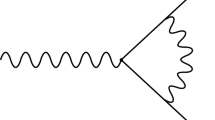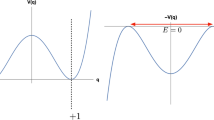Summary
We present a general method for analyzing the consequence of the symmetries in the dual amplitudes. We show that the existence of the generalized gauge transformation is related not only to the reflection symmetry but also to the cyclic symmetry of the dual amplitudes. We give the explicit form for the generator of the gauge transformation in two different formalisms for theN-point function. Other transformation operators present in these formalisms are also investigated.
Riassunto
Si presenta un metodo generale per analizzare la conseguenza delle simmetrie nelle ampiezze duali. Si dimostra che l'esistenza della trasformazione di gauge generalizzata è collegata non soltanto alla simmetria di riflessione ma anche alla simmetria ciclica delle ampiezze duali. Si fornisce la forma esplicita per il generatore della trasformazione di gauge in due formalismi differenti per la funzione aN punti. Si studiano altri operatori di trasformazione presenti in questi formalismi.
Резюме
Мы предлагаем общий метод для анализа следствия симметрий в дуальных амплитудах. Мы показываем, что существование обобщенного калибровочного преобразования связано не только с симметрией отражения, но также с циклической симметрией дуальных амплитуд. Мы приводим точную форму для генератора калибровочного преобразования в двух различных формализмах дляN-точечной функции. Также исследуются операторы других преобразований, представленные в этих формализмах.
Similar content being viewed by others
Referenes
G. Veneziano:Nuovo Cimento,57 A, 190 (1968).
The five-point function was given byK. Bardakçi andH. Ruegg:Phys. Lett.,28 B, 342 (1968); and byM. A. Virasoro:Phys. Rev. Lett.,22, 37 (1969).
The generalization to an arbitraryN-point function was given byH. M. Chan:Phys. Lett.,28 B, 425 (1969);H. M. Chan andTsou S. Tsun:Phys. Lett.,28 B, 485 (1969);C. Goebel andB. Sakita:Phys. Rev. Lett.,22, 257 (1969);K. Bardakçi andH. Ruegg:Phys. Rev.,181, 1884 (1969).
A generalization to theN-point function was also given byZ. Koba andH. B. Nielsen:Nucl. Phys. B10, 633 (1969).
S. Fubini andG. Veneziano:Nuovo Cimento,64 A, 811 (1969).
K. Bardakçi andS. Mandelstam:Phys. Rev.,184, 1640 (1969).
S. Fubini, D. Gordon andG. Veneziano:Phys. Lett.,29 B, 679 (1969);Y. Nambu: University of Chicago preprint EFI 69-64 (1969).
C. B. Chiu, S. Matsuda andC. Rebbi:Phys. Rev. Lett.,23, 1526 (1969).
F. Gliozzi: Torino preprint (1969).
C. B. Thorn: Berkeley preprint (1969).
D. Amati, M. Le Bellac andD. Olive: CERN preprint (1969).
H. Stapp: Trieste preprint (1969). A formalism similar to that of Stapp's has also been discussed in ref. (11)D. Amati, M. Le Bellac andD. Olive: CERN preprint (1969).
L. Caneschi, A. Schwimmer andG. Veneziano:Phys. Lett.,30 B, 351 (1969).
S. Sciuto: Torino preprint (1969).
Although the three-resonance vertex function was derived in ref. (14)S. Sciuto: Torino preprint (1969) (also ref. (13)L. Caneschi, A. Schwimmer andG. Veneziano:Phys. Lett.,30 B, 351 (1969), with asymmetric definitions for the three relevant propagators, the expression of eq. (5.14) as given in ref. (13)L. Caneschi, A. Schwimmer andG. Veneziano:Phys. Lett.,30 B, 351 (1969) should in fact correspond to that for symmetric definitions of original propagators. We thank Dr.L. Caneschi for informing us on this point.
Author information
Authors and Affiliations
Additional information
Work supported in part by the U.S. Atomic Energy Commission. Prepared under Contract AT(11-1)-68 for the San Francisco Operations Office, U.S. Atomic Energy Commission.
Address after September, 1970: Institute for Advanced Study, Princeton, N.J.
Traduzione a cura della Redazione.
Переведено редакцией.
Rights and permissions
About this article
Cite this article
Chiu, C.B., Matsuda, S. & Rebbi, C. A general approach to the symmetry and the factorization properties of theN-point dual amplitudes. Nuovo Cimento A (1965-1970) 67, 437–473 (1970). https://doi.org/10.1007/BF02728533
Received:
Published:
Issue Date:
DOI: https://doi.org/10.1007/BF02728533




